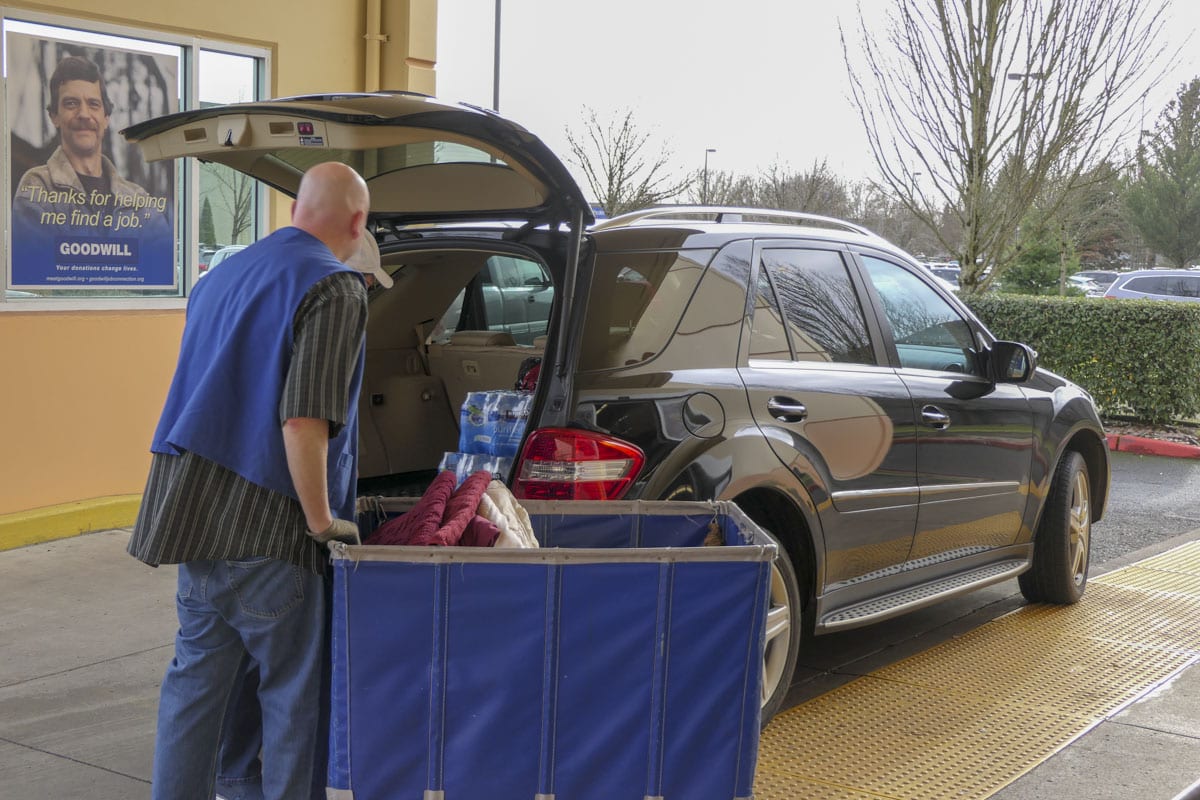Nonprofits had been concerned the increased standard deduction would mean fewer people giving
VANCOUVER — At the Goodwill store on 162nd Avenue, a steady stream of cars pull into the donation drop-off area with loads of things they no longer need. Some take a receipt, but many decline.
“In the last two weeks of this year, this one store will receive more than 300,000 pounds of donations,” says Dale Emanuel with Goodwill Columbia-Willamette. “Out of 98 places you can donate in our system, it’s number one. Nearly eight million pounds, up 12 percent from this time last year.”

That increase comes as a relief to Goodwill. The Trump Administration’s tax reform bill, passed on 2017, nearly doubled the standard deduction. The Tax Policy Center estimated the change would reduce the number of people claiming itemized deductions by 50 percent this year.
Frank Carlisle, who was dropping some items off at the Fisher’s Landing Goodwill, said his wife is an accountant, so they were well aware of the change in tax law. Still, he said it had no bearing on whether or how much they would give to charity.
“Actually we’re moving out of state soon and we’re actually giving more to charity,” he says. “We have a fund that we build up every year and we donate to different causes.”
“I haven’t been able to deduct in years,” laughed Gayle, who dropped some stuff off after Frank. “Ever since I got rid of my mortgage I haven’t had a deduction worth squat.”
Goodwill relies on donations, and the sales of those items, to fund a number of charitable causes, including their Job Connection program. Emanuel says they were able to help 3,100 people locally last year, and expect that number to be higher this year.
But Goodwill also provides funding for other local charities.
“Nonprofits work together, really helping the same folks in different stages of their life,” says Emanuel. “So we really hope people will be mindful when they think of giving to their favorite charities and continue to give.”

But nonprofits like Goodwill may be somewhat insulated from the changed tax deduction rules. After all, in a good economy when people are buying more, they will also be looking to unload stuff they no longer want or need. Emanuel says the people they’ve talked to plan to continue giving because it helps them, helps others, and helps keep stuff out of local landfills.
But what about other local charities. Janie Spurgeon is vice president of development at Community Foundation of Southwest Washington, which helps to sponsor other local charities through grants.
“I think the residents of Southwest Washington see needs in our community,” says Spurgeon, “and are going to continue to support charities that they know and love, and that are doing good work, no matter what the tax consequences are.”
During their annual Give More 24 fundraiser last September they raised $1.36 million for 155 local nonprofits, from over 3,697 individual donors.
Spurgeon says that was a new record, “both in number of people who gave, as well as the overall amount raised … So we didn’t see any strange thing that happened there that would make us think ‘oh, maybe this tax law change has made people not as generous.’ We haven’t seen any of that.”
So, at least for this year, it doesn’t seem as if charities are being heavily impacted by the tax law change.
Greg Railsback, a Certified Public Accountant with over two decades of experience, says he’s talked with a lot of his clients about the change, and doesn’t anticipate that it will have a major effect on whether people decide to give.
“I’ve not had a conversation with a single client that says ‘well now because I can qualify for the standard deduction and I don’t need to itemize, I’m not going to give money to charity,’” he says.
“I think that those who give at meaningful, significant levels will still continue to do so and would, in my estimation, continue to do so even if they got no tax benefit from it,” Railsback adds. “Because it’s who they are. It’s the values that they live their life by.”
He does add one caveat, that this may reflect the values more of their clients than the world at large, and their clients tend to reflect the values Railsback and his partners have.
“The majority of our clients don’t give and support their churches, or other organizations, solely because of the tax benefits,” says Railsback.
What about 2019?
While this year seems to be playing out with little impact from the new tax law for local nonprofits, the same may not be true in 2019. That’s because some donors may decide to ‘bunch’ their charitable contribution. That’s a strategy that allows them to essentially set aside their usual donations in 2019, then pay it out in January of 2020, before giving as usual throughout the rest of that year.
“Come April, when people are starting to get their taxes done, (and start) to really understand ‘oh, OK, this is how this might be affecting me,'” says Spurgeon. “And so it would be interesting to, at this same time next year, look at things and see if people are really utilizing that bunching strategy.”
Railsback says he doesn’t expect a large number of people to take advantage of stacking their charitable contributions, but if they do, “I’ve recommended that they communicate with those organizations that they support at a significant level,” so that they aren’t caught off guard by the missing contributions next year.
Still, Railsback adds that there can be a fundamental misunderstanding of the way people use the charitable giving tax deduction.
“It’s not like a dollar for dollar reduction, so it still costs you something to give,” he says. “So there’s always had to be more motive behind giving than a tax benefit. The tax benefit is like the cherry on top.”
Added to that is the fact that the tax law as approved by Congress in 2017 and signed by the president, includes a sunset on many of the individual tax benefits. That includes the higher standard deduction.
“We’re telling our clients at some point this is going to go away. I mean just look at the deficit, it, at this point, does not appear sustainable,” Railsback says. “So don’t increase your lifestyle expenses based on these tax savings because, at some point in time your tax liability is going back up.”




